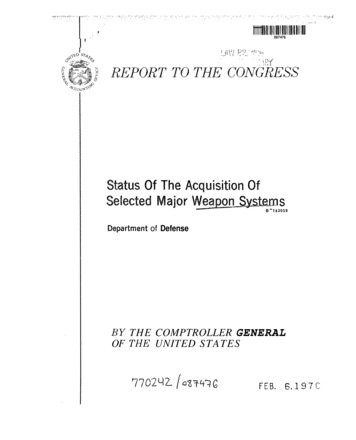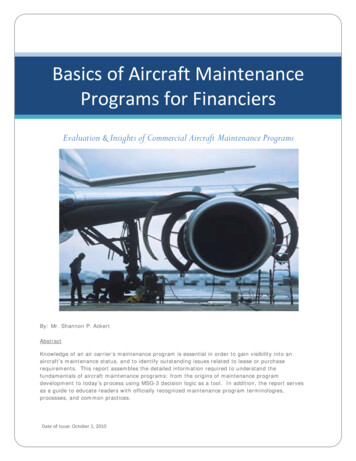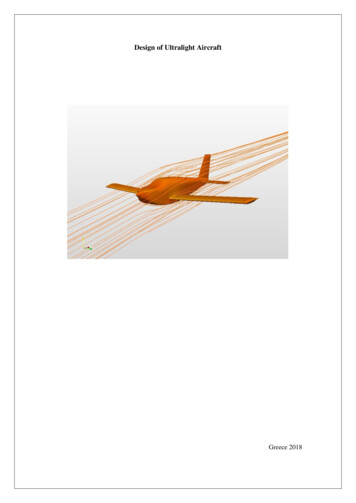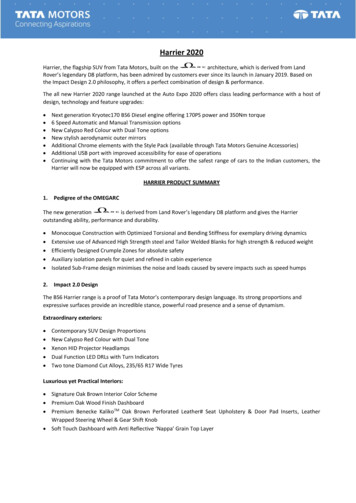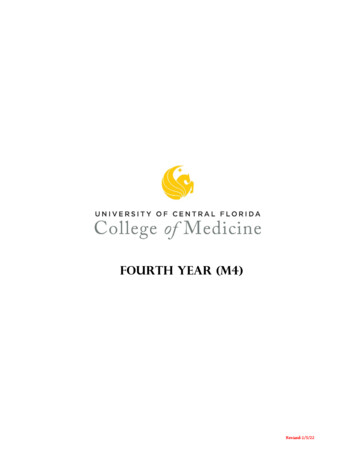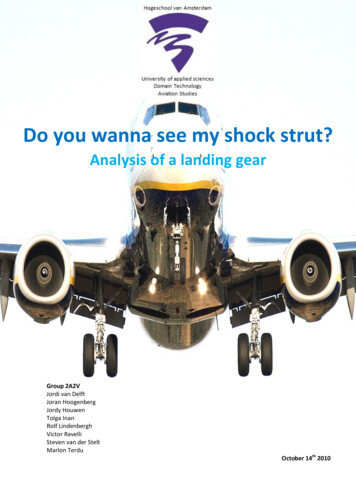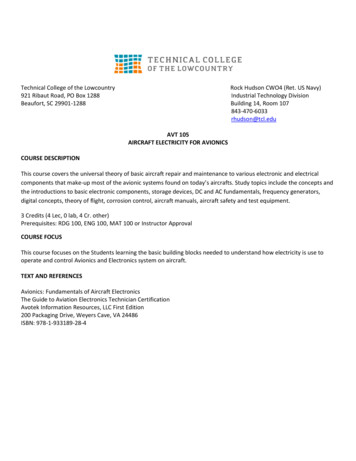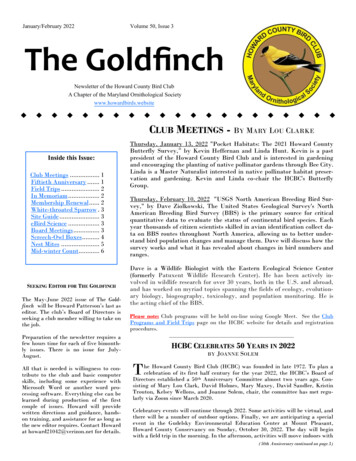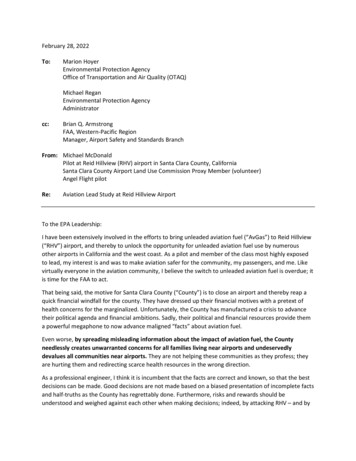
Transcription
February 28, 2022To:Marion HoyerEnvironmental Protection AgencyOffice of Transportation and Air Quality (OTAQ)Michael ReganEnvironmental Protection AgencyAdministratorcc:Brian Q. ArmstrongFAA, Western-Pacific RegionManager, Airport Safety and Standards BranchFrom: Michael McDonaldPilot at Reid Hillview (RHV) airport in Santa Clara County, CaliforniaSanta Clara County Airport Land Use Commission Proxy Member (volunteer)Angel Flight pilotRe:Aviation Lead Study at Reid Hillview AirportTo the EPA Leadership:I have been extensively involved in the efforts to bring unleaded aviation fuel (“AvGas”) to Reid Hillview(“RHV”) airport, and thereby to unlock the opportunity for unleaded aviation fuel use by numerousother airports in California and the west coast. As a pilot and member of the class most highly exposedto lead, my interest is and was to make aviation safer for the community, my passengers, and me. Likevirtually everyone in the aviation community, I believe the switch to unleaded aviation fuel is overdue; itis time for the FAA to act.That being said, the motive for Santa Clara County (“County”) is to close an airport and thereby reap aquick financial windfall for the county. They have dressed up their financial motives with a pretext ofhealth concerns for the marginalized. Unfortunately, the County has manufactured a crisis to advancetheir political agenda and financial ambitions. Sadly, their political and financial resources provide thema powerful megaphone to now advance maligned “facts” about aviation fuel.Even worse, by spreading misleading information about the impact of aviation fuel, the Countyneedlessly creates unwarranted concerns for all families living near airports and undeservedlydevalues all communities near airports. They are not helping these communities as they profess; theyare hurting them and redirecting scarce health resources in the wrong direction.As a professional engineer, I think it is incumbent that the facts are correct and known, so that the bestdecisions can be made. Good decisions are not made based on a biased presentation of incomplete factsand half-truths as the County has regrettably done. Furthermore, risks and rewards should beunderstood and weighed against each other when making decisions; indeed, by attacking RHV – and by
extension many other small general aviation airports – the County undermines all of aviation and thegood that comes with it. Indeed, it is my strong belief that supporting aviation supports the community.This letter is intended to identify and correct the record on some of the claims made by the Countyregarding lead. This letter does not address FAA grant assurance issues with the County which I haveseparately addressed with the FAA. Nor does it explore the economic impact of general aviation andwhat the closure of RHV could economically mean to the region; more information on that is alsoavailable upon request.This letter focuses specifically on lead research from Santa Clara County that has been sent to the EPA. Asummary of the short-comings of that research is presented, followed by a more extensive review ofthese issues.It is important that the EPA get the analysis on aviation fuel right to ensure constrained health careresources are properly allocated; at the same time, it is also important that communities are notified ofthe true risk, to decrease possible misclassification of children and unnecessary concern by parents.I ask that the EPA thoughtfully consider and evaluate these issues in identifying next steps regarding thetransition to unleaded AvGas; I applaud this ultimate goal.Respectfully,Michael McDonaldCommunity and Airport Partnership for Safe Operation (CAAPSO) Board MemberSanta Clara County Airport Land Use Commission (ALUC) MemberAngel Flight Pilot
SummaryThe County took actions on January 1, 2022, that prohibited the sale of leaded AvGas at County-ownedairports. These actions were ostensibly taken based on the results of a study (“Study”) that the Countycommissioned to evaluate the potential impact of AvGas on blood lead levels (“BLLs”) at RHV. 1If correct, the Study found that there is a correlation between leaded AvGas sales at RHV and child BLLs;an increase in one will increase the other. Just as importantly, the converse applies: if leaded AvGassales are eliminated, child BLLs will not be elevated. As the County has eliminated leaded AvGas sales atthe airport, the concern by the County that the airport and airplanes elevate BLLs is no longer relevantas leaded AvGas is no longer sold by virtue of the County’s actions.If correct, the Study results also show that no special action is needed. As opined by a Yale UniversitySchool of Medicine physician and researcher who provided a peer review of the Study, “this finding isnot a crisis” and there are “some important differences” to the Flint, MI crisis. The CDC provides a BLLreference value of 3.5 micrograms per deciliter (µg/dL) for case management; this level represents theworst 2.5% of the population’s BLL levels and prioritizes this population for medical and environmentalfollow-up; below this level, physicians take no action. The Study found the mean level for those locatedclosest to the airport was 1.93 µg/dL, which is below the current CDC reference value and far below theCDC reference values – 5 µg/dL and 10 µg/dL – in effect during the time period covered in the Study.Furthermore, those in the Study above the CDC reference value represented only 1.7% of thepopulation, which is less than the 2.5% benchmark set by the CDC.However, it should be noted that the data used in the Study is fundamentally flawed, and so the Studyitself should be questioned. BLL testing equipment was developed in the 1990s to detect elevated BLLsabove 10 µg/dL. With the substantial reduction of community BLLs since that time, this equipment isinadequate to accurately and precisely test at current BLLs; this is a limitation recognized in the industry.The Study assumes a precision and accuracy in the data that unfortunately is not supported by theequipment used to do the test.Some of the assumptions, techniques, and conclusions in the Study also deserve scrutiny.(1) The Study’s selection of the epicenter of lead deposits at the northwest end of the field versusthe southeast end is inconsistent with prior research; given the Study’s conclusions on impactsto communities within 0.5 miles of the airport and those downwind from the aircraft, correctlyidentifying the epicenter of lead deposits 3000’ to the southwest may have a profound impacton results, as well as indicate a lower risk for many children and schools.(2) The Study assumes no lead-based paint was used in homes built after 1960; this is inconsistentwith reality, as well as the County’s own position (based on lawsuits) and California state law, allof which say that lead may exist in any California home built before 1978.(3) The Study does not explore the potential contribution of major lead sources that were prevalentimmediately around RHV for decades: (1) lead-arsenate, the leading pesticide used in the localorchards surrounding the airport, (2) legacy automotive leaded gas used at the NASCAR race“Leaded Aviation Gasoline Exposure Risk at Reid-Hillview Airport in Santa Clara County, California,” MountainData Group, August 3, 2021.1
track directly adjacent to RHV, (3) legacy automotive leaded gas from the major road arteries ofTully Rd and Capital Expressway that intersect adjacent to RHV, and (4) lead pipes and fixtures.(4) The Study ignores that communities south (downwind) of the airport had the lowest BLL, andinstead focused on the communities east (also downwind) of the airport that had higher BLL;the former goes against the County’s thesis.(5) The Study’s researcher explored but did not include a correlation of BLL to actual leadmeasurements from an EPA-required air emissions lead meter that is at RHV; it is concerningthat potentially contradictory results were omitted from an “unbiased” scientific Study.Independent analysis of lead levels should also be considered, especially where they provide acontradictory result. At my request, the Bay Area Air Quality Management District (BAAQMD) providedEPA-mandated lead measurements for RHV from January 2016 through 2021; these levels weresubstantially better than EPA National Acceptable Air Quality Standards (NAAQS). Further highlightingthat this is not a true crisis, BAAQMD indicated it intends to petition the EPA to discontinue testingbased on the low lead levels found at RHV.The County position that all lead must be eliminated is a good soundbite and admirable goal, but is anextreme position, economically impractical, and the risk/reward ratio does not support it. Some of thelargest contributors to the world’s economy permit small levels of lead; these products includeautomotive gasoline (lead, as a natural byproduct of petroleum, is permitted in automotive fuel),conventional vehicle batteries, and cell phones, among many other things. Simply put, fully eliminatingall lead would, for starters, shut down transportation, anything that requires transportation, and billionsof cell phones.The County actually has an opportunity to validate the research, but has been unwilling to do so, furtherhighlighting their specious health arguments. The Study indicates that BLLs should go down with theCounty’s actions to stop the sale of unleaded fuel; this can now be validated a positive correlationwould show that the County’s actions have reduced BLLs in the community, and a negative correlationwould indicate that aviation did not lead to an increase in BLLs. Both results would be positive for thecommunity, but neither align with the County’s political agenda of closing the airport and so aren’tbeing pursued. In addition, while the County is now conducting additional lead studies of RHV, theyrefuse to include a forensic analysis of the source of the lead which would serve to better target the realsources of lead and more effectively use constrained health budgets; their lack of interest in thishighlights a political – and not a health – agenda. If their real interest was community health, theyshould have supported these research opportunities.In addition, the EPA should consider the economic and practical impact of closing airports due to leadcontamination. For example, if excavation is desired down to three feet, a one acre parcel would requirethe removal of 12 million pounds of soil; as RHV is 180 acres, it would be necessary to remove nearly 2.2billion pounds of soil. While capping is another solution, it requires massive amounts of clean dirt and isalso not a permanent solution. As there are thousands of general aviation airports near communities,the economic expense of the EPAs decision may be tremendous.Finally – and, frankly, unrelated to lead – I wish to make clear the life-saving services that will beeliminated if an adverse EPA or FAA decision closes small airports and keeps small airplanes from flying.General aviation airports like RHV – including Santa Monica, Palo Alto, and San Carlos and numerousother airports under specious attacks – and small airplanes play a vital role in providing thousands of
annual “Angel Flights,” whereby individuals with illnesses are flown in to receive life-saving treatments.The certain health crisis and economic hardships these individuals will face must be considered in anyactions of the EPA.Details of these points will now follow.
County’s Actions Eliminating Leaded AvGas Substantially Eliminates the RiskIf correct, the Study found that there is a correlation between leaded AvGas sales at RHV and child BLLs;an increase in one results in an increase in the other. 2 Just as importantly, the converse applies: if leadedAvGas sales are eliminated, child BLLs will go down.Figure 1 Aviation Gasoline Sales at Reid-Hillview Airport and Child BLLs (page 46)As the County has eliminated leaded AvGas sales at the airport, AvGas aviation sales at RHV are, bydefinition, zero. As stated in the report,the estimated positive association between child BLLs and PEA [piston engine aircraft] traffic isrobust to the substitution of PEA traffic for the quantity of aviation gasoline sold at Reid-HillviewAirport, an analogous and independent indicator of lead exposure. The size of the estimatedincrease in child BLLs in going from the minimum to maximum PEA traffic exposure is on par withthe increase in child BLLs caused by failures in the water system during the FWC [Flint WaterCrisis]. 3Specifically, the Study found that the difference between the observed maximum to the minimum isassociated with a decrease in 0.18 µg/dL. The County has eliminated leaded AvGas sales, so the23Mountain Data Group, (46).Ibid.6
predicted BLLs are now 0.18 µg/dL less. Therefore, there is now no need to close the airport because ofa concern over lead exposure.The County will possibly argue that some aircraft continue to use leaded fuel from elsewhere andtherefore the risk remains. Importantly, that was also the case during the Study, as numerous aircraftdeparting RHV purchase their fuel at other less expensive locations. The Study also only made estimatesdown to 5000 gallons in annual sales; the County has effectively brought that down even further,enabling even lower BLLs than shown in the Study.Blood Lead Levels Found Near RHV are not Actionable nor a CrisisIf correct, the Study results also show that no special action is needed. This is a manufactured crisis ofthe County’s own making.As opined by Dr. Mark Cullen, a Yale University School of Medicine Physician and Researcher, who didthe County’s peer review of the Study,[T]his finding is not a crisis. Although reference is made in the report to the debacle in the Flintdrinking water several years ago, and the incremental lead effect is quantitatively similar,there are some important differences. The population impacted is relatively small, the impact isseasonal, and most importantly, only 1-2% of the measured levels, even with the attributableexposure, reached the "action level" for removal from exposure if I understood correctly. Whilethe view that no level of exposure is safe is currently the predominant view among experts, thereremains debate about how steep the effect on IQ is in the very low range, which is the basis forthe cost estimate in terms of impact on lifetime earnings of the "airport effect” I am alsomindful of the risk that the airport could become an undue focus of community anxiety abouthealth, when there may be better targets for this energy in the pandemic era. 4to which Dr. Zahran, the author of the Study, replied:Finally, with respect to Dr. Cullen’s assessment of the implications of reported results, we agreefully with the spirit of his remarks that one must be judicious in the allocation of scarceresources in attending to questions of population health and welfare. We agree with all of hisdistinctions between the Flint Water Crisis – that we use to contextualize the meaning ofobserved "airport" effects throughout – and exposure to lead-formulated aviation gasoline atRHV. 5Sadly, Dr. Cullen’s prediction that this could become “an undue focus of community anxiety” has beenexacerbated by the County’s own actions; the County consistently incorrectly compares this to Flintknowing full well this creates a community anxiety that can be leveraged to close the airport.A little more explanation on why this is not a crisis. The national CDC currently provides a BLL referencevalue of 3.5 µg/dL for case management; during the period of the study, this CDC BLL reference valuewas 10 µg/dL (2011) and 5µg/dL (2012 through May, 2021). This reference value represents a thresholdof the worst 2.5% of the population’s BLL levels and prioritizes this population for medical and“Response to External Reviews of Leaded Aviation Gasoline Exposure Risk at Reid-Hillview Airport in Santa ClaraCounty, California”, Mountain Data Group, August 13, 2021 (p. iii).5Ibid, (p. v).47
environmental follow-up; below this level, physicians take no action aside from general education. Aseveryone in society has a positive BLL, this reference level enables physicians to prioritize those athighest risk and similarly allows those under this threshold to not be unduly concerned (or terrorized bythe County, in this case).The Study found the mean level for those located closest to the airport was 1.93 µg/dL, which is belowthe current CDC reference value and far below the CDC reference values – 5µg/dL and 10 µg/dL – inplace during the Study’s timeframe. In other words, for the average child living closest to RHV, theyshould NOT be concerned; they do not have an actionable BLL.At the high end, the Study found that about 1.7% of the population had a BLL in excess of 4.5 µg/dL 6;this is less than the 2.5% benchmark set by the CDC. Put differently, of the 17,162 people tested overthe 10 years of the Study, 1.7% is roughly 29 children annually with an elevated BLL. 7 The Countyestimates that 12,805 children live within the Study area 8; 29 children annually is therefore roughly0.2% of the children living within 1.5 miles of the airport that apparently have an elevated BLL.This is clearly not a community crisis.With respect to the County’s constant misleading and incorrect refrain in the press and to governmentagencies that the “RHV lead exposure is worse than the Flint Michigan lead crisis”: the Study explicitlyindicates that the switch in water source in Flint caused child BLLs to increase by about 0.35 to 0.45μg/dL from a pre-crisis baseline of about 2.3 μg/dL. 9 In contrast, aviation lead at RHV contributed farless than Flint, MI and had a baseline of far less than Flint, MI; shown below are the actual results of theStudy. 10Mountain Data Group, (p. 10)Mountain Data Group, (p. 34). In the County’s January 11, 2022 response to the FAA, the County incorrectlyindicated that 300,000 records - not 17,162 - were used in the Study.8Santa Clara County response to the FAA, January 11, 2022. (p. 4)9Mountain Data Group, (p. 37)10Mountain Data Group, (p. 36)678
While the claim may be true in terms of percentage increase, they do not appear true in terms of actualnumbers.Study Concerns: Relies on Equipment Performance that Does Not ExistWith the substantial reduction of community BLLs, BLL test equipment is inadequate to accurately andprecisely test at the levels found in the Study.BLL testing equipment was developed in the 1990s to detect elevated BLLs above 10 µg/dL.11 Thecurrent United States regulatory limits for BLL testing were set more than 25 years ago, at 4 μg/dL or10% of the target value, whichever is greater. 12 Most laboratories can achieve a performance of at least 2 μg/dL at low blood Pb levels. 13 The current US criteria mean a BLL sample of 5 μg/dL could bereported within a range from 1 to 9 μg/dL, and still be considered correct. As the report explicitly states,“This makes interpreting patient blood Pb test results uncertain at low levels.” 14This is a limitation recognized in the industry:Accuracy and precision may be insufficient to quantitate low blood Pb levels in the 1–5 μg/dLrange, which is essential now that the CDC blood Pb reference value is 3.5 μg/dL 15The Study assumes a precision and accuracy in the data that cannot be accomplished with today’sequipment.“Determination of lead in blood by graphite furnace atomic absorption spectrometry with Zeeman backgroundcorrection: Improving a well-established method to support a lower blood lead reference value for children”,Spectrochimica Acta Part B: Atomic Spectroscopy, 2021.12ibid13ibid14ibid15ibid119
As an example, the FDA-approved Magellan Diagnostics familyof BLL testing equipment – including LeadCare II, LeadCare Plus,and LeadCare Ultra – is commonly used in nontraditionallaboratory settings such as federally funded Women, Infants,and Children clinics, other health clinics, physician office labs,schools and mobile health units. In 2013, the LeadCare II wasthe only point-of-care instrument available in the US; it has areportable range of 3.3 to 65 µg/dL, which lies outside of theaverage range found in the Study. 16, 17A different example is the Magellan DX LeadCare Plus, thatallows measurements down to 1.9 µg/dL but has a standarddeviation of 0.49 over multiple runs when testing around amean BLL of 3.1 µg/dL (the lowest number that they cite). 18The CDC issued a recall on all Magellan Diagnostics BLLequipment on July 2, 2021, due to inaccurate readings, furtherunderscoring the potential lack of accuracy and precision of thedata used in the Study. 19Very precise and accurate laboratory equipment such asgraphite furnace atomic absorption spectrometry (GFAAS) alsohave significant errors in precision and accuracy at these lowFigure 2 LeadCare-Plus Precision and Accuracylevels. Shown below is a table showing two such devices; theNIST known-levels are compared to the outputs of the two devices. Note specifically the errors formeasurements at 1.48 µg/dL, which most closely coincides with the levels found in the Study: onemachine returned a value of 1.4 0.3 µg/dL (meaning 1.1 to 1.7 across multiple tests), while anotherone returned a value of 1.6 0.4 µg/dL (meaning 1.2 to 2.0 across multiple tests). 20These are high-precision devices that exceed FDA standards and requirements; they are the benchmarkfor the more commonly used BLL testers such as those from Magellan Diagnostics (note lower portion ofFigure 2). It is simply exceedingly difficult to accurately and precisely measure differences that are in thesingle-digit parts-per-billion range, which is what is called for when measuring sub-1 µg/dL differencesas is done in the Study. nes for Measuring Lead in Blood Using Point of Care Instruments,” Advisory Committee on ChildhoodLead Poisoning Prevention Of the Centers for Disease Control and Prevention, October 24, 2013.18LeadCare-Plus brochure. Magellan Diagnostics, ctrochimica Acta Part B: Atomic Spectroscopy, 2021.211 µg/dL 10 parts per billion161710
Figure 3 Analysis of NIST reference material for BLL on the PE AAnalyst 600 and PE PinAAcle 900Z. Source: Spectrochimica ActaPart B: Atomic Spectroscopy, 2021Study Concerns: Used Incorrect EpicenterThe Study identifies the epicenter of lead deposits as the northwest end of the field, at the far end ofrunway 31 (as opposed to its beginning); based on prior research, this was incorrect and potentiallyfundamentally changes the outcome of the Study. By placing the epicenter 3000’ to the southwest – atthe beginning of runway 31 and near the run-up area – this relocates distances in the study by over 0.5miles.Given the importance of 0.5 miles distance in the Study, this is a major change. Within 0.5 milesdownwind of this new location is primarily Eastridge Mall and its parking lot; many kids and schoolsthought to be within the critical 0.5 miles of influence now fall outside of it. Locations that were thoughtto be downwind are now upwind. Specifically, Meyer Elementary becomes upwind instead of downwindand moves from 0.1 mi to 0.6 mi; Kathy Smith Elementary becomes crosswind instead of downwind; anda fair number of schools and children move from out of the 1.5 mile area of interest around RHV.In a study prepared for the US EPA in January 2010, the climb-out emitted 32.7% of the emissions; theclimb-out is where the epicenter in the Study is located. The other modes of operation – or 67.2% of theemissions – occur downwind of the Study’s epicenter. 22“Development and Evaluation of an Air Quality Modeling Approach for Lead Emissions from Piston-EngineAircraft Operating on Leaded Aviation Gasoline,” ICF International and T&B Systems for the US EPA, January 2010.2211
Figure 4 Pb Emissions (kg/yr) by Aircraft Mode (2008) at Santa Monica in EPA studyThese regions, assuming typical prevailing winds (i.e. favoring operations on runway 31R/31L) aredepicted on RHV below. As can be clearly seen, only a portion of the climb-out is near the epicenteridentified in the Study; the majority of lead emissions occurs downwind of this location.Figure 5 Various modes of flight as it pertains to Reid Hillview airportIt is therefore not surprising that the Bay Area Air Quality Management District (BAAQMD) performs itsEPA-mandated airport lead testing at “2”, adjacent to the runup and downwind from the majority oflead emissions; this is the opposite end from where the Study identifies the epicenter of lead exposure.Study Concerns: Used Incorrect Lead Paint Cut-off DateThe Study assumes no lead-based paint was used in homes built after 1960; this is inconsistent with theEPA’s recommended cut-off date, the County’s own position (based on lawsuits against paint12
companies) and California state law, all of which say that lead paint is presumed in all California homesbuilt before 1978. 23, 24, 25Study Concerns: Did Not Adequately Explore Relevant Alternative SourcesThe Study lacked any meaningful analysis of critical potential sources of lead in the area surrounding theairport. These include the following: Lead ArsenateRHV was surrounded by orchards. The Emma Prusch Park is an example historical orchard still inexistence and is less than 1 mile away from RHV. Many of the schools within 1 mile of RHV are within asimilar distance to this orchard; these schools are also downwind from the orchard.Lead Arsenate was a routine orchard pesticide used in Santa Clara County since the 1800s through the1940s; it was finally banned in August 1988. 26 Farmers liked the “long-lasting” properties of thepesticide; it is that same persistence that is causing environmental problems decades after its use hasended. 27Lead arsenate poisoning from orchards can have a significant impact on a community. Barber Orchard inNorth Carolina is an example of an EPA superfund site that was caused by lead arsenate pesticide usedin former orchards. 28 The EPA required nearly 15 years to remediate this site before it could be reused.As the CDC points out, “people who live near busy highways or on old orchard land where lead arsenatepesticides were once used can be exposed to higher levels of lead.” 29Despite the orchards in the area, lead arsenate was not considered inthe Study. Legacy Automotive Fuel – RacetrackRHV was adjacent to the “NASCAR West” motor speedway, a NASCARsanctioned track that operated from 1954 until it closed onSeptember 3, 1977; it had weekly races.Figure 6 Reid Hillview airport adjacentto the oval NASCAR racetrack“Protect Your Family From Lead in Your Home,” EPA, September 2013.“Experts, Federal Agencies, Physician Associations, and the Public Entities Agree That Lead Paint Is the PrimarySource of Lead Exposure for Young Children Living In Pre-1978 Housing” was one section in the state decision “THEPEOPLE OF THE STATE OF CALIFORNIA, Plaintiff, vs. ATLANTIC RICHFIELD COMPANY” and others (Case No.: 1-00CV-788657)25California Department of Public Health, TITLE 17, Division 1, Chapter 9, Article 2, §37100 (a)(3).26“Current Conditions Report Hazards and Hazardous Materials Envision San Jose 2040 General Plan Update”,February 12, 2010. (p. 9)27A nice review of lead arsenate may be found in “The apple bites back: claiming old orchards for residentialdevelopment.” Environmental health perspectives vol. 114,8 (2006): A470-6. supercpad/SiteProfiles/index.cfm?fuseaction second.Cleanup&id ead toxzine.html232413
Research has now found that the average race emitted more than 10 kilograms of lead— “a quantitysimilar to the annual emissions of an average airport.” 30To reiterate, “NASCAR West” operated weekly races for nearly 23 years. Two schools are now built onor adjacent to this former racetrack. It was not considered as a source of lead in the Study. Legacy Automotive Fuel – Nearby HighwaysTwo major thoroughfares abut RHV: Capital Expressway and Tully Road. A major mall was built at thissame intersection, given its access to these major thoroughfares. It would be interesting to understandthe contribution of these highways and this major intersection to BLLs in the area.In Santa Clara County, it is estimated in county reports that there is nearly 22000 times more lead fromlegacy automotive fuel than from aviation; the Santa Clara County Office of Education lead reportindicates 13,000 metric tons (13,000,000 kg) of lead exists from legacy automotive fuel. 31 By contrast, a2008 EPA study estimated RHV generated 580 kilograms of lead annually. 32Clearly the impact of lead from legacy automotive fuel in the County far outweighs the impact of RHV. Lead PipingLead pipes are more likely to be found in older cities and homes built before 1986. Among homeswithout lead service lines, the most common problem is with brass or chrome-plated brass faucets andplumbing with lead solder. EPA estimates that drinking water can make up 20 percent or more of aperson’s total exposure to lead. Infants who consume mostly mixed formula can receive 40 percent to60 percent of their exposure to lead from drinking water. 33There is no apparent evaluation or consideration of lead pipes in the analysis, nor any consideration tofixtures and solder that might exist in the home. Given that the age of the housing stock in the Studyaligns with the period when lead solder was used in homes as well as the demographics of thepopulation, this possible substantial risk should have been considered.Perhaps interestingly, RHV marks the exact border between the Evergreen water district (which liesgenerally “downwind” from the airport) and San Jose Water (which lies generally “upwind” from theairport). The sources of these waters, their treatm
Feb 28, 2022
